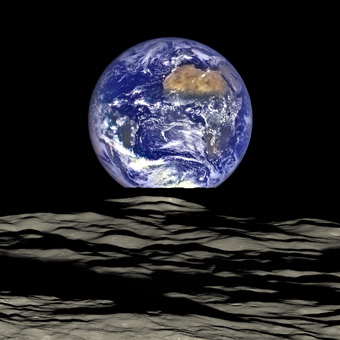
Image courtesy of NASA/JPL
Earthrise, 2016: Welcome to a New Year
| published January 7, 2016 |
By Thursday Review editors
In an eerie redux of the iconic photo taken more than 40 years ago by astronaut William Anders during his Apollo 8 mission, and another photo captured by astronaut Harrison Schmitt on his Apollo 17 mission to the moon, a recent digital photograph captured by NASA’s Lunar Reconnaissance Orbiter (LRO) revisits elements of the same compositions with startling and striking clarity.
Schmitt’s famous December 1972 photo, which he dubbed “Blue Marble,” became not only one of the most recognizable images from the era of manned missions to the lunar surface, but also a widely disseminated symbol of the unity and oneness of planet Earth. Schmitt took his famous photo from inside the Apollo spacecraft when it was roughly 28,250 miles from Earth.
Schmitt’s 1972 photograph is believed to be the only picture of a “full Earth” ever taken by a human—all others taken from the surface of the moon or from other Apollo missions included shadow, darkness or terminator line (night/day boundary) prominent in the photo.
Anders' Christmas eve 1968 photo, called "Earthrise," also became an iconic image, culturally important for the way the image captures the environmental sensitivity of Earth in direct contrast to the barren, stark landscape of the moon. Apollo 8 commander Frank Borman used the same Hasselblad camera as Anders to take several additional, similar compositions as the crew members traded the camera back and forth for 15 minutes. Anders image has been used in motion pictures, on album covers, on magazine covers, and on postage stamps in scores of countries. Life magazine ranked among the 100 most important images ever captured with a camera, and wilderness photographer Galen Rowell has called it "the most influential environmental photograph ever taken."
This newest "Earthrise" image (it was actually taken in December 2015, a few weeks ago) required NASA to engage in some digital tinkering, however, since only some of the LRO’s cameras capture imagery in color, and some only capture imagery in black and white. NASA says that this dramatic Earthrise is a composite image using the Wide Angle digital color camera for the upper half and the Narrow Angle high resolution camera (which only shoots in black and white) for the lunar surface region of the photo. Thus photo purists might dispute the overall authenticity of the completed image, though all elements of the picture were captured at the same instant.
In this photo, Africa can be clearly seen in the right hand area of the Earth image, with the lighter colors of the Sahara and the Arabian Peninsula visible as the sandy beige regions between the cloud systems.
Related Thursday Review articles:
Spacewalk: Making Room for Rendezvous; Keith H. Roberts; Thursday Review; December 22, 2015.
Earth's Portrait, One Million Miles Away; Thursday Review staff; Thursday Review; July 29, 2015.
